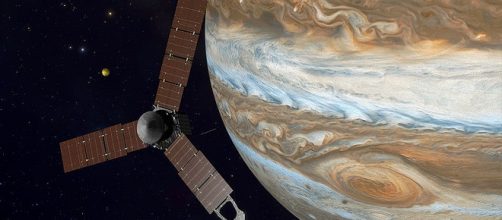The spacecraft Juno, which was deployed to Jupiter by NASA in 2011, reached the gaseous orb on July 4, 2016. Its mission is to journey to Jupiter in the hopes of gaining information into the complex planet by attempting to see beyond the clouds that coat the planet's atmosphere. NASA expects to learn more about how the planet was formed and how it has changed.
Recently, NASA released imagery of storm clouds over Jupiter's surface, wowing the world with the unexpected beauty of the planet.
Juno's mission to Jupiter a raging success.
The information gleaned from the spacecraft has given scientists a phenomenal peek into the mysterious planet.
Juno's most recent round of amazing photos knocked the socks off scientists and citizens alike. So far, most of the images of Jupiter show a planet that seems to have layers of colors, much like a marble. But the more recent ones depict Jovian clouds that glow with a beautiful blue tint. The following tweet from NASA gives an up-close look at the complicated, yet gorgeous, Jovian clouds.
😮 NASA’s Juno spacecraft was a little more than one Earth diameter from Jupiter when it captured this mind-bending, color-enhanced view of the planet’s tumultuous atmosphere. https://t.co/Nur6W7CQrS pic.twitter.com/VjkLTzPbAC
— NASA360 (@NASA360) January 8, 2018
"Jovian clouds in striking shades of blue in this new view taken by NASA’s Juno spacecraft" https://t.co/PHFszfoj9m pic.twitter.com/zKQspIpD8a
— pourmecoffee (@pourmecoffee) December 4, 2017
"Jovian clouds in striking shades of blue in this new view taken by NASA’s Juno spacecraft" https://t.co/PHFszfoj9m pic.twitter.com/zKQspIpD8a
— pourmecoffee (@pourmecoffee) December 4, 2017
Jupiter and Juno in mythology
Interestingly enough, Juno gets its name from Greek and Roman mythology.
For the Romans, Jupiter was a god of the sky, and Juno was his wife. According to NASA, "Jupiter hid behind clouds so no one could see him causing trouble. But Juno could see through the clouds."
Since the mission of the spacecraft is specifically to see through the clouds of Jupiter, so closely resembling the story of the mythological god and goddess, the probe was appropriately given the name Juno.
NASA could potentially extend the Juno mission to Jupiter
While the spacecraft Juno was originally planned to orbit Jupiter for two years, from July 2016 to July 2018, scientists at NASA could potentially extend the mission past the current expectation, if all goes well. As long as the probe continues to gather useful information about the gas giant, the decision to send the spacecraft delving into the violent surface of the planet could be put off indefinitely.
Preserving Juno as long as possible is a high priority for many scientists at NASA. Thomas Zurbuchen, associate administrator for the Science Mission Directorate at NASA, stated the following last year.
"Juno is healthy, its science instruments are fully operational, and the data and images we've received are nothing short of amazing. The decision to forego the burn is the right thing to do - preserving a valuable asset so that Juno can continue its exciting journey of discovery."
While Zurbuchen was speaking on a different topic regarding Juno, his words nevertheless would make a good argument to extending the mission past the current end date, so long as the probe is in good working condition.
The future remains to be seen, but at this time, Juno is providing NASA with everything they expected, and more.


